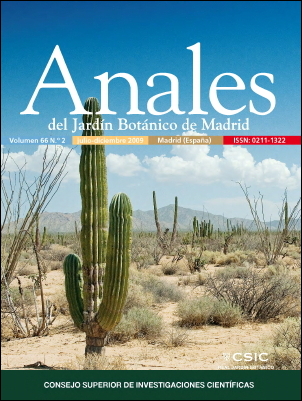Superando problemas de extracción de ADN de plantas carnívoras
DOI:
https://doi.org/10.3989/ajbm.2198Palabras clave:
plantas carnívoras, extracción del ADN, polifenoles, polisacáridos, metabolitos secundarios, mucílago viscosoResumen
Probamos algunos protocolos publicados previamente para el aislamiento del ADN de plantas con alto contenido de polifenoles y polisacáridos para varios táxones de plantas carnívoras. Sin embargo, no conseguimos muy buenos resultados ni con tejidos de hojas frescas, ni con tejidos de hojas secadas en gel de sílice obtenidas de plantas colectadas en el campo o cultivadas en los invernaderos, ni de especímenes de herbario. Por lo tanto, hemos desarrollado un protocolo sencillo, modificado del Macherey- Nagel NucleoSpin® Plant kit disponible en el mercado para el aislamiento rápido, eficaz y reproducible de ADN genómico de alta calidad conveniente para la reacción en cadena de la polimerasa. La extracción del ADN se puede realizar en tejidos de hojas frescas o secas de varios táxones de plantas carnívoras, sin importar el grado de contenido de polisacáridos, compuestos fenólicos u otros metabolitos secundarios que interfieren con el aislamiento y la amplificación del ADN.
Descargas
Citas
Bekesiova, I., Nap, J.P. & Mlynarova, L. 1999. Isolation of high quality DNA and RNA from leaves of the carnivorous plant Drosera rotundifolia. Plant Molecular Biology Reporter 17: 269-277. doi:10.1023/A:1007627509824
Doyle, J.J. & Doyle, J.L. 1987. A rapid DNA isolation procedure from small quantities of fresh leaf tissues. Phytochemical Bulletin 19: 11-15.
Fang, G., Hammar, S. & Grumet, R. 1992. A quick and inexpensive method for removing polysaccharides from plant genomic DNA. BioTechniques 13: 52-56. PMid:1503775
Hasebe, M., Omori, T., Nakazawa, M., Sano, T., Kato, M. & Iwatsuki, K. 1994. RbcL gene sequences provide evidence for the evolutionary lineages of leptosporangiate ferns. Proceedings of the National Academy of Sciences of the USA 91: 5730-5734. doi:10.1073/pnas.91.12.5730
Jay, M. & Lebreton, P. 1972. Chemotaxonomic research on vascular plants 26. The flavonoids of the Sarraceniaceae, Nepenthaceae, Droseraceae and Cephalotaceae; a critical study of the order Sarraceniales. Naturaliste Canadienne 99: 607-613.
Juniper, B.E., Robins, R.J. & Joel, D.M. 1989. The Carnivorous Plants. Academic Press. London.
Katterman, F.R.H. & Shattuck, V.I. 1983. An effective method of DNA isolation from the mature leaves of Gossypium species that contain large amounts of phenolic terpenoids and tannins. Preparative Biochemistry 13: 347-359. doi:10.1080/00327488308068177
Lloyd, F.E. 1934. Is Roridula carnivorous? Canadian Journal of Research 10: 780-786.
Lodhi, M.A., Ye, G.N., Weeden, N.F. & Reisch, B.I. 1994. A simple and efficient method for DNA extraction from grapevine cultivars, Vitis species and Ampelopsis. Plant Molecular Biology Reporter 12: 6-13. doi:10.1007/BF02668658
Loomis, W.D. 1974. Overcoming problems of phenolics and quinones in the isolation of plant enzymes and organelles. Methods in Enzymology 31(Pt A): 528-544.
Macherey-Nagel. 2007. NucleoSpin®Plant: Genomic DNA from Plant User manual, June 2007/Rev. 6. Macherey-Nagel GmbH & Co. KG. Düren.
Maliyakal, E.J. 1992. An efficient method for isolation of RNA and DNA from plants containing polyphenolics. Nucleic Acids Research 20: 2381. doi:10.1093/nar/20.9.2381 PMid:1375739 PMCid:312364
Müller, K., Borsch, T., Legendre, L., Porembski, S., Theisen, I. & Barthlott, W. 2004. Evolution of carnivory in Lentibulariaceae and the Lamiales. Plant Biology 6: 477-490. doi:10.1055/s-2004-817909 PMid:15248131
Nicholls, K.W., Bohm, B.A. & Ornduff, R. 1985. Flavonoids and affinities of the Cephalotaceae. Biochemical Systematics and Ecology 13: 261-263. doi:10.1016/0305-1978(85)90036-5
Porebski, S., Bailey, L.G. & Baum, B.R. 1997. Modification of a CTAB DNA extraction protocol for plants containing high polysaccharide and polyphenol components. Plant Molecular Biology Reporter 15: 8-15. doi:10.1007/BF02772108
Richards, E. 1988. Preparation of genomic DNA from plant tissue. In: Ausubel, F.M. & al. (eds.), Current Protocols in Molecular Biology. Greene Publishing Associates and Wiley-Interscience. New York.
Rost, K. & Schauer, R. 1977. Physical and chemical properties of the mucin secreted by Drosera capensis. Phytochemistry 16: 1365-1368. doi:10.1016/S0031-9422(00)88783-X
Schlauer, J., Budzianowski, J., Kukulczanka, K. & Ratajczack, L. 2004. Acetoside and related phenylethanoid glycosides in Byblis liniflora Salisb. plants propagated in vitro and its systematic significance. Acta Societatis Botanicorum Poloniae 73: 9-15.
Schlauer, J., Nerz, J. & Rischer, H. 2005. Carnivorous plant chemistry. Acta Botanica Gallica 152: 187-195.
Sheridan, P.M. & Griesbach, R.J. 2001. Anthocyanidins of Sarracenia L. Flowers and Leaves. Hortscience 36: 384.
Shioda, M. & Marakami-Muofushi, K. 1987. Selective inhibition of DNA polymerase by a polysaccharide purified from slime of Physarum polycephalum. Biochemical and Biophysical Research Communications 146: 61-66. doi:10.1016/0006-291X(87)90690-5
Stange, C., Prehn, D. & Arce-Johnson, P. 1998. Isolation of Pinus radiata Genomic DNA Suitable for RAPD Analysis. Plant Molecular Biology Reporter 16: 1-8. doi:10.1023/A:1007540901981
Tel-Zur, N., Abbo, S., Myslabodski, D. & Mizrahi, Y. 1999. Modified CTAB procedure for DNA isolation from epiphytic cacti of the genera Hylocereus and Selenicereus (Cactaceae). Plant Molecular Biology Reporter 17: 249-254. doi:10.1023/A:1007656315275
White, T.J., Bruns, T., Lee, S. & Taylor, J. 1990. Amplification and direct sequencing of fungal ribosomal RNA genes for phylogenetics. In: Innis, M.A. & al. (eds.), PCR Protocols - a guide to methods and applications, United Kingdom edition: 315-322. Academic Press. San Diego.
Wollenweber, E. 2007. Flavonoids occurring in the sticky resin on Roridula dentata and Roridula gorgonias (Roridulaceae). Carnivorous Plant Newsletter 36: 77-80.
Descargas
Publicado
Cómo citar
Número
Sección
Licencia
Derechos de autor 2009 Consejo Superior de Investigaciones Científicas (CSIC)

Esta obra está bajo una licencia internacional Creative Commons Atribución 4.0.
© CSIC. Los originales publicados en las ediciones impresa y electrónica de esta Revista son propiedad del Consejo Superior de Investigaciones Científicas, siendo necesario citar la procedencia en cualquier reproducción parcial o total.
Salvo indicación contraria, todos los contenidos de la edición electrónica se distribuyen bajo una licencia de uso y distribución “Creative Commons Reconocimiento 4.0 Internacional ” (CC BY 4.0). Consulte la versión informativa y el texto legal de la licencia. Esta circunstancia ha de hacerse constar expresamente de esta forma cuando sea necesario.
No se autoriza el depósito en repositorios, páginas web personales o similares de cualquier otra versión distinta a la publicada por el editor.















